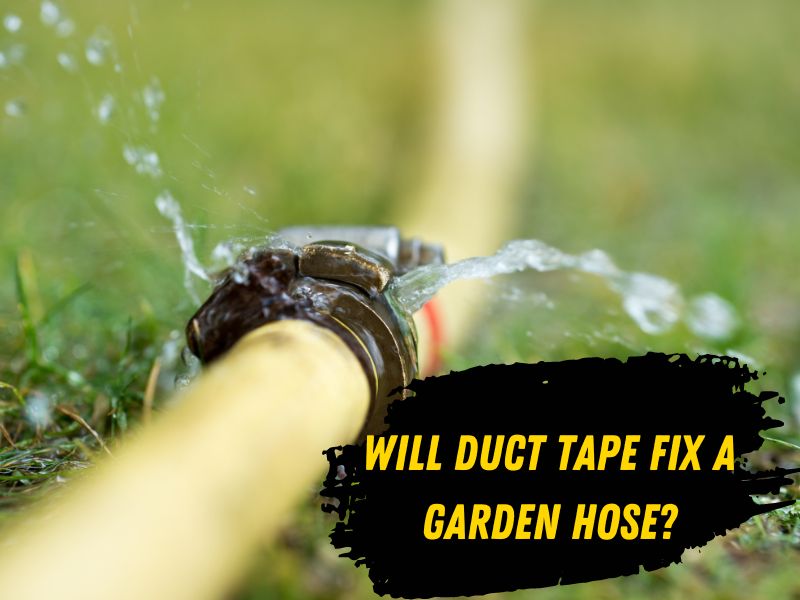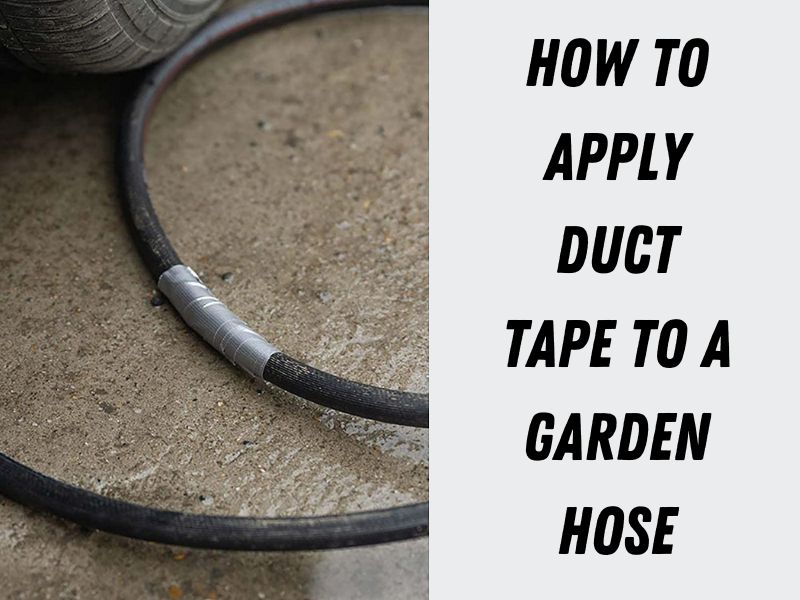When you are a homeowner or a gardener, you rely on your garden hose to water your plants and keep your lawn maintained. On the other hand, garden hoses can occasionally acquire problems that cause them to become inoperable. It’s possible that you’ll find yourself wondering, “Will duct tape fix a garden hose?” at some point.
In this piece, we’ll discuss the potential drawbacks of using duct tape to fix garden hoses as well as the advantages of doing so.
Importance of Repairing Garden Hoses
Repairing garden hoses is crucial not only to prevent water waste but also to save money and time. Instead of buying a new garden hose every time a leak or crack occurs, repairing it can be a cost-effective solution. Additionally, repairing a garden hose instead of replacing it reduces waste and contributes to a more sustainable lifestyle.

Duct Tape 101
Duct tape, also known as duck tape, is a strong, adhesive tape that was first developed during World War II for use in military applications. It is made from a fabric or plastic backing with a rubber-based adhesive, making it highly resistant to moisture, heat, and chemicals.
Duct tape is available in a variety of colors and widths, and some versions are even designed for specific applications, such as automotive repairs or HVAC systems.
Despite its versatility, duct tape has some limitations and drawbacks when it comes to repairing garden hoses. For example, duct tape may not be strong enough to hold up to the pressure of water flowing through a garden hose, and it may not provide a long-lasting fix. Additionally, duct tape may not be able to adhere well to certain types of garden hose materials.
Can Duct Tape Fix a Garden Hose?
Now, let’s address the question on everyone’s mind: can duct tape fix a garden hose? The short answer is yes, but with some limitations.
Duct tape can be used to fix small leaks, cracks, and splits in garden hoses. However, it’s important to note that duct tape is not a permanent solution and may only provide a temporary fix. Over time, the duct tape may peel or become damaged, leading to further issues with the hose.
In addition, duct tape may not be strong enough to fix larger issues with garden hoses, such as significant cracks or splits. In these cases, replacing the hose altogether may be more cost-effective and efficient.
Alternatives to Duct Tape
While duct tape can be a quick and easy fix for small issues with garden hoses, there are other methods you can use for more significant problems. Some alternative methods for fixing garden hoses include:
Hose Mender
A hose mender is a simple and affordable solution for fixing leaks in garden hoses. It involves cutting out the damaged section of the hose and replacing it with a hose mender, a small plastic or metal piece connecting the two ends of the hose. Hose menders are widely available at hardware and home improvement stores.
Hose Clamps
Hose clamps are another option for repairing garden hoses. They work by clamping a rubber or plastic patch onto the damaged area of the hose, creating a watertight seal. Hose clamps come in various sizes to fit different hose diameters and can be purchased at hardware stores.
Epoxy Putty
Epoxy putty is a type of adhesive that can be used to repair small holes or cracks in garden hoses. It comes in two parts that are mixed together to create a malleable putty that can be applied to the damaged area of the hose. Once it dries, epoxy putty forms a strong and durable seal.
How to Apply Duct Tape to a Garden Hose

If you’ve decided to use duct tape to fix a small issue with your garden hose, here’s how to do it:
- Clean the area around the damaged section of the hose with a damp cloth to remove any dirt or debris.
- Dry the area thoroughly with a clean cloth.
- Tear off a length of duct tape that is long enough to cover the damaged section of the hose, with some extra length on either side.
- Apply the duct tape firmly to the hose, starting at one end of the damaged section and wrapping it tightly around the hose.
- Continue wrapping the duct tape around the hose, making sure to overlap each layer by about half the width of the tape.
- Once you have covered the damaged section of the hose with several layers of duct tape, wrap the tape tightly around the entire circumference of the hose for added reinforcement.
- Check for any gaps or loose areas in the duct tape and apply additional layers as needed.
Pros And Cons Of Using Duct Tape To Fix a Garden Hose?
Using duct tape to mend a garden hose can be a quick and easy solution for many homeowners, gardeners, and DIY enthusiasts. However, like any repair method, it has its pros and cons. Here are some of the key advantages and disadvantages of using duct tape to mend a garden hose:
Pros:
- Duct tape is an inexpensive and easily accessible solution for small leaks or holes in a garden hose.
- It can be a quick and temporary fix until a more permanent solution is found.
- Duct tape is easy to apply, and requires no special tools or equipment.
Cons:
- Duct tape is not designed for watertight repairs and may not provide a long-lasting fix for a leaky garden hose.
- The adhesive on the duct tape may break down over time, causing the tape to become loose or fall off.
- Wrapping duct tape too tightly around a garden hose may cause it to wrinkle, creating additional leaks or compromising the integrity of the hose.
Comparing the Effectiveness and Cost of Duct Tape with Other Methods
When deciding between duct tape and other repair methods, it is important to consider both the effectiveness and cost of each option. While duct tape may be a convenient and inexpensive solution, it may not always provide a long-lasting fix. Here are some factors to consider when comparing duct tape with other repair methods:
- Severity of Damage: For minor leaks or cracks, duct tape may be a sufficient solution. However, a hose mender or hose clamp may be a more effective choice for more serious damage.
- Longevity: While duct tape can provide a temporary fix, it is not designed to be a long-lasting solution. Hose menders and hose clamps, on the other hand, can provide a more permanent fix.
- Cost: Duct tape is generally the most affordable option for repairing garden hoses. Hose menders and hose clamps may cost more upfront, but they can be a more cost-effective solution in the long run if they provide a more permanent fix.
- Ease of Use: Duct tape is generally easy to apply and requires no special tools or skills. On the other hand, hose menders and hose clamps may require some basic plumbing skills to install properly.
DIY Garden Hose Repairs vs. Professional Help
While many homeowners prefer to tackle home repairs on their own, not every DIY project is suitable for everyone. When it comes to repairing a garden hose, it’s important to consider your skills and experience and the severity of the issue.
When to Attempt DIY Repairs on Your Garden Hose
If you’re confident in your ability to work with tools and are familiar with basic plumbing concepts, you may be able to successfully repair your garden hose on your own. Some common garden hose issues that can be resolved with DIY repairs include:
- Small punctures or tears in the hose
- Leaks at the connections or fittings
- Clogs or blockages in the hose
- In these cases, repairing your garden hose with duct tape or other DIY methods may be a cost-effective solution allowing you to return to your gardening tasks quickly.
Situations Where it’s Best to Seek Professional Help
If you’re dealing with a more serious issue, such as a large tear in the hose or a damaged internal lining, it may be best to seek professional help. Additionally, if you’re uncomfortable working with tools or plumbing systems, attempting DIY repairs on your garden hose could be dangerous.
FAQs
Is duct tape a permanent solution for garden hose repair?
While duct tape can be an effective short-term solution for certain garden hose issues, it is not a permanent fix. Over time, the adhesive on the duct tape can degrade and the tape may begin to peel away from the hose, requiring further repairs.
Can I use duct tape to repair a garden hose that has a large tear or hole?
While duct tape can be used to repair small punctures or tears in a garden hose, it is not a suitable solution for larger holes or tears. In these cases, it’s best to seek professional help or replace the hose altogether.
How often should I inspect and maintain my garden hose?
It’s a good idea to inspect your garden hose at least once per year, before the start of the gardening season. Regular maintenance can help prevent issues from developing and prolong the life of your hose.
What should I do with a garden hose that is beyond repair?
If your garden hose is beyond repair, it’s important to dispose of it properly. Many local recycling centers accept garden hoses, and some manufacturers offer recycling programs for their products.
Conclusion
Duct tape can provide a quick fix for certain garden hose issues, it is not a long-term solution. In many cases, seeking professional help or considering alternative repair methods may be best.
To prevent garden hose damage and prolong its lifespan, it is essential to practice proper maintenance and handling techniques. Regularly inspecting your garden hose for damage, storing it properly, and avoiding kinks and twists can help prevent leaks and cracks.
We hope this article has provided you with useful information on repairing and maintaining your garden hose. Remember to always prioritize safety when attempting DIY repairs and seek professional help when in doubt.
